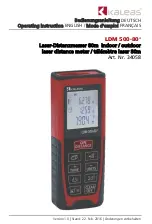
Sphensor
–
User manual
LSI LASTEM SRL
INSTUM_04291
Pag. 23 / 32
5
Deepening
5.1
Time synchronization
All devices connected to the radio network are properly synchronized to keep up to date the date/time used
for recording data or to identify diagnostic reports (date/time of occurrence of a certain event).
The synchronization takes place through periodic
broadcast
or
unicast
messages generated by the Sphensor
Gateway configured as time synchronization authority; the always active network equipment, receiving the
broadcast message, synchronize their clock to the date/ time indicated; the presence of a small delay is de-
termined by the repetition of the broadcast signal in the entire network, due to its passage from one or more
reception points, and it is considered acceptable according to the type of measurement application envisaged
for this product.
Considering that the low-power equipment does not receive the broadcast message except when they turn
on to transmit their data, the system time is deliberately requested by these devices to their reference node
(or parent) which is presumably already synchronised by a previous message.
The system considers that one or more sensors may not be synchronised for a certain period of time, espe-
cially after they are switched on. In this condition, which is assumed to persist for a limited time, the sensor
is not able to perform local recording of the measured data.
6
Diagnostics
6.1
Functional status LEDs
Each sensor has blue and red LEDs; the two colors can be switched on independently or at the same time to
provide the possibility of a third color.
The sensor can individually manage each of the following light signals :
•
Correctly connected network status signal (1 fast blue flash)
•
Missing/disconnected network status signal (1 fast red flash)
•
Local alarm signal (3 fast red flashes)
•
Low battery level signal (2 slow red flashes)
Reports shall be repeated cyclically over time according to the set parameters (§
Errore. L'origine riferimento
non è stata trovata.
).
At each signaling cycle, the priority to display the state of the network is as follows (starting from the highest
priority one): local alarm, battery, connected/disconnected status (individually manageable but mutually ex-
clusive).
Signalling of an abnormal functional condition shall be indicated by red staining and shall be defined as fol-
lows:
•
No detected functional abnormalities: no signalling.
•
Critical battery level, measurement operation and radio transmission suspended: a short flash.
•
Low battery level, normal operation anyway: two short flashes.










































